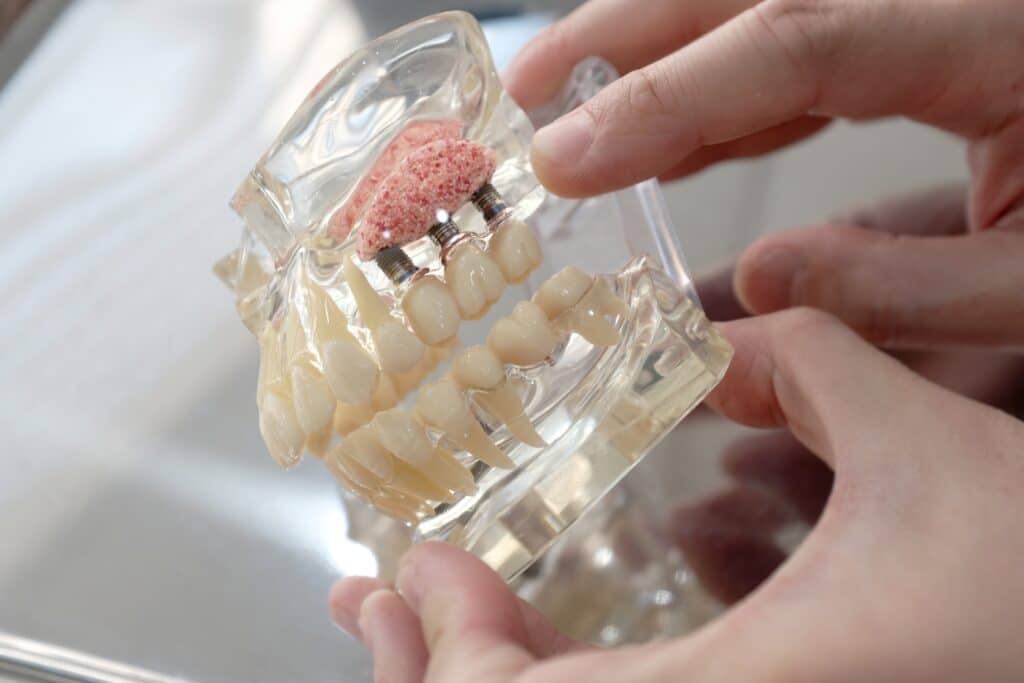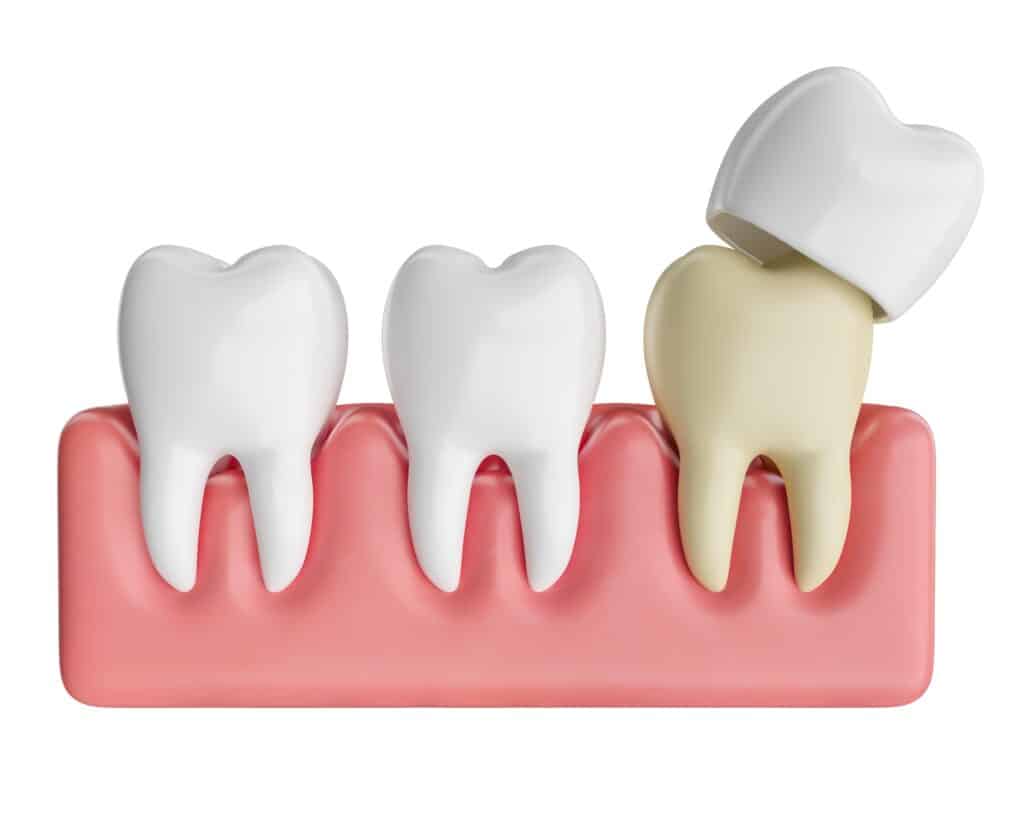There are two types of diseases that can affect the gums: gingivitis and periodontitis. Together, gingivitis and periodontitis are referred to as gum disease or periodontal disease. The National Institute of Health defines periodontal (gum) disease as “inflammation and infection that destroys the tissues that support the teeth, including the gums, the periodontal ligaments, and the tooth sockets (alveolar bone).”
Gum Disease Types & Treatment
Both types of gum diseases are fairly common among adults in the United States and both can be stopped or their symptoms lessened with effective care.
What is gum disease (gingivitis)?
Gingivitis, the earliest stage of gum disease, is inflammation of the tissues surrounding and supporting the teeth and is most commonly a result of poor dental hygiene. Gum disease, Gingivitis is a very common condition and varies widely in severity. If left untreated in the early stages, gingivitis can lead to more severe oral health issues. It is characterized by red, swollen gums that bleed easily when teeth are brushed or flossed. Gingivitis is not the same thing as periodontitis. It always precedes and acts as a warning sign for the more serious condition of periodontitis.
Gingivitis Causes
In addition to poor oral hygiene, according to the NIH, gingivitis can be caused by:
- uncontrolled diabetes
- some systemic diseases and infections, such as thyroid disorders, nutrient deficiencies, or HIV infection
- certain medications, including phenytoin (used to control seizures), bismuth (used to treat upset stomach and diarrhea, as in Pepto-Bismol)
- some birth control pills
- misaligned teeth
- rough-edged fillings
- ill-fitting or unclean mouth appliances
Furthermore, there is a hormonal component to gingivitis, as changes in hormones can cause greater gum sensitivity. For this reason, pregnant women sometimes get gingivitis and the disease often develops during puberty or young adulthood.
Symptoms
Many people aren’t aware that they have gingivitis. It’s possible to have gum disease without any symptoms. However, the following can be symptoms of gingivitis:
- gums that are red, tender, or swollen
- bleed when you brush or floss your teeth
- gums that have pulled away from the teeth
- loose teeth
- a change in how your teeth fit together when you bite (malocclusion)
- pus between teeth and gums
- pain when chewing
- sensitive teeth
- partial dentures that no longer fit
- foul-smelling breath that doesn’t go away after you brush your teeth
Does Gum Disease Go Away? (Gingivitis) Gum disease Treatment
You must practice proper oral hygiene to treat gingivitis. You should also cut back on any smoking and control your diabetes. Other gum disease treatments include:
- deep cleaning your teeth and removing plaque
- antibiotic medications
- surgery
Periodontitis Gum Disease
If gingivitis is not treated, it may lead to periodontitis — a much more serious disease. Periodontitis can lead to the destruction of gums, mouth bone loss, tissue, and teeth. It is the number one cause of tooth loss in adults. If plaque spreads too much below the gum line, toxins can cause the tissues and bone that support the teeth to break down. The National Institute of Dental and Craniofacial Research explained that, in periodontitis, gums pull away from the teeth, forming spaces called pockets, which become infected. If not treated, risk factors include teeth becoming loose and having to be removed. Periodontitis can also increase the risk of other medical conditions such as heart attack or stroke, according to the Mayo Clinic.
Periodontitis Gum Disease Types
- Chronic periodontitis, the most common form, is characterized by pocket formation and gum recession. It can occur at any age but is most common in adults.
- Aggressive periodontitis is characterized by rapid loss of gums and bone destruction.
- Periodontitis as a manifestation of systemic diseases is associated with heart disease, diabetes, and respiratory diseases. It usually sets in at a young age.
- Necrotizing periodontal disease is characterized by necrosis (death) of gum tissue, periodontal ligaments, and alveolar bones, which cause lesions. It is most common in people with systemic conditions like HIV, malnutrition, and immunosuppression.
Periodontitis Gum Disease Treatment
There are both non-surgical and surgical gum disease treatments for periodontitis, depending on if it is in the early or advanced stages.
Nonsurgical treatments include:
- Scaling: The removal of tartar and bacteria from teeth and beneath gums. This is usually done in standard professional teeth cleaning.
- Root planing: Smoothing the root surfaces to discourage the further buildup of tartar and bacterial toxins.
- Antibiotics: May include topical antibiotics like mouth rinses and gels, or oral antibiotics.
Surgical treatments include:
- Flap surgery (pocket reduction surgery): Lifting back the gum tissue, exposing the roots for more effective scaling and root planing. The underlying bone may be recontoured so that it will be easier to clean the area around the gums.
- Soft tissue grafts: This reinforces soft tissue lost to gum recession. A small amount of tissue from the roof of the mouth is relocated to the gum line in order to reduce further gum loss, cover exposed roots and improve appearance.
- Bone grafting: This is done when the bone around the tooth root has been destroyed and helps prevent tooth loss by holding the tooth in place. It also promotes bone regrowth.
- Guided tissue regeneration: This promotes the regrowth of bone through the use of a biocompatible fabric being placed between the bone and tooth. The material prevents unwanted tissue from growing so that the bone can grow back.
- Enamel matrix derivative application: This procedure, another form of guided tissue regeneration, involves the application of gel to a diseased tooth root. The gel contains the same proteins that naturally exist in developing tooth enamel. Its application stimulates healthy bone and tissue growth.
Does gum disease cause bad breath?
Bad breath, or halitosis, is most frequently associated with gum disease. The oral bacteria that are present in the mouth release chemical gases called volatile sulfur compounds that have a strong odor. Bad breath can also come from the bacterial plaque that builds up on the tongue. When the plaque and tartar are removed from the teeth and tongue with regular:
- brushing
- flossing
- professional dental cleanings
The halitosis can be eliminated. This is the easiest way to reverse bad breath, but it can take a while for the mouth odor to completely disappear. A person needs to be consistent and persistent with oral hygiene to reverse the condition.
Regency Family Dentistry Omaha
Whether your teeth needs are a complete exam and regular dental cleaning, a full-mouth restoration, or anything in between, we promise to provide you with exceptional care as we enhance the natural beauty of your smile. Below are just some of the many procedures and dental services we regularly provide to our patients – with a gentle touch, and stunning results. Your smile is our first priority, and we’ll give you something to smile about.
Preventative Dentistry
- Dental Exams
- Dental Cleanings
- Oral Cancer Exam
- Fluoride Treatment
- Sealants
- Dental X-Rays
- Home Care
- Nightguards & Mouthguards
Cosmetic Dentistry
- Dental Implants
- Composite Fillings
- Porcelain Crowns
- FixedPorcelain Bridges
- Porcelain Veneers
- Tooth Whitening
Periodontal Disease
- What is Periodontal (Gum) Disease?
- Diagnosis
- Treatment
- Maintenance
Restorative Dentistry
- Dental Implants
- Inlay Restorations
- Onlay Restorations
- Composite Fillings
- Crowns
- Dentures & Partial Dentures
- Fixed Bridges
- Root Canal Therapy
Oral Surgery
- Wisdom Teeth Extractions




